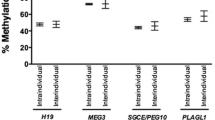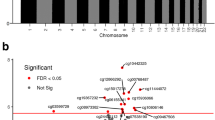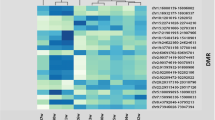Abstract
Children born preterm are reported to be at increased risk of developing noncommunicable diseases in later life. Altered placental DNA methylation patterns are implicated in fetal programming of adult diseases. Our earlier animal studies focus on micronutrients (folic acid, vitamin B12) and long-chain polyunsaturated fatty acids (LCPUFAs) that interact in the I carbon cycle, thereby influencing methylation reactions. Our previous studies in women delivering preterm show altered plasma levels of micronutrients and lower plasma LCPUFA levels. We postulate that alterations in the micronutrient metabolism may affect the regulation of enzymes, methionine adenosyltransferase (MAT2A), and SAH-hydrolase (AHCY), involved in the production of methyl donor S-adenosylmethionine (SAM), thereby influencing the methylation potential (MP) in the placenta of women delivering preterm. The present study, therefore, examines the mRNA, protein levels of enzymes (MAT2A and AHCY), SAM, S-adenosylhomocysteine (SAH) levels, and global DNA methylation levels from preterm (n = 73) and term (n = 73) placentae. The enzyme messenger RNA (mRNA) levels were analyzed by real-time quantitative polymerase chain reaction, protein levels by enzyme-linked immunosorbent assay, and SAM-SAH levels by high-performance liquid chromatography. The mRNA levels for MAT2A and AHCY are higher (P < .05 for both) in the preterm group as compared to the term group. S-Adenosylmethionine and SAH levels were similar in both groups, although SAM:SAH ratio was lower (P < .05) in the preterm group as compared to the term group. The global DNA methylation levels were higher (P < .05) in women delivering small for gestation age infants as compared to women delivering appropriate for gestation age infants at term. Our data showing lower MP in the preterm placenta may have implications for the epigenetic programming of the developing fetus.
Similar content being viewed by others
References
Howson CP, Kinney MV, McDougall L, Lawn JE; Born Too Soon Preterm Birth Action Group. Born Too Soon: preterm birth matters. Reprod Health. 2013;10(suppl 1):S1.
Blencowe H, Lee AC, Cousens S, et al. Preterm birth-associated neurodevelopmental impairment estimates at regional and global levels for 2010. Pediatr Res. 2013;74(suppl 1):17–34.
Lawn JE, Davidge R, Paul VK, et al. Born too soon: care for the preterm baby. Reprod Health. 2013;10(suppl 1):S5.
Hecht JL, Allred EN, Kliman HJ, et al. Histological characteristics of singleton placentas delivered before the 28th week of gestation. Pathology. 2008;40(4):372–376.
Hirnes KP, Simhan HN. Risk of recurrent preterm birth and placental pathology. Obstet Gynecol. 2008;112(1):121–126.
Armstrong-Wells J, Post MD, Donnelly M, Manco-Johnson MJ, Fisher BM, Winn VD. Patterns of placental pathology in preterm premature rupture of membranes. J Dev Orig Health Dis. 2013;4(3):249–255.
Maccani MA, Marsit CJ. Epigenetics in the placenta. Am J Reprod Immunol. 2009;62(2):78–89.
Vo T, Hardy DB. Molecular mechanisms underlying the fetal programming of adult disease. J Cell Commun Signal. 2012;6(3):139–153.
Reynolds LP, Caton JS. Role of the pre- and post-natal environment in developmental programming of health and productivity. Mol Cell Endocrinol. 2012;354(1-2):54–59.
Crider KS, Yang TP, Berry RJ, Bailey LB. Folate and DNA methylation: a review of molecular mechanisms and the evidence for folate’s role. Adv Nutr. 2012;3(1):21–38.
Joseph J, Loscalzo J. Methoxistasis: integrating the roles of homocysteine and folic acid in cardiovascular pathobiology. Nutrients. 2013;5(8):3235–3256.
Khulan B, Cooper WN, Skinner BM, et al. Periconceptional maternal micronutrient supplementation is associated with widespread gender related changes in the epigenome: a study of a unique resource in the Gambia. Hum Mol Genet. 2012;21(9):2086–2101.
Kulkarni A, Dangat K, Kale A, Sable P, Chavan-Gautam P, Joshi S. Effects of altered maternal folic acid, vitamin B12 and docosahexaenoic acid on placental global DNA methylation patterns in Wistar rats. PLoS One. 2011;6(3):e17706.
Khot V, Kale A, Joshi A, Chavan-Gautam P, Joshi S. Expression of genes encoding enzymes involved in the one carbon cycle in rat placenta is determined by maternal micronutrients (folic acid, vitamin B12) and omega-3 fatty acids. Biomed Res Int. 2014;2014:613078.
da Silva VC, Fernandes L, Haseyama EJ, et al. Effect of vitamin B deprivation during pregnancy and lactation on homocysteine metabolism and related metabolites in brain and plasma of mice offspring. PLoS One. 2014;9(4):e92683.
Kramer DL, Porter CW, Borchardt RT, Sufrin JR. Combined modulation of S-adenosylmethionine biosynthesis and S-adenosylhomocysteine metabolism enhances inhibition of nucleic acid methylation and L1210 cell growth. Cancer Res. 1990;50(13):3838–3842.
Dhobale M, Chavan P, Kulkarni A, Mehendale S, Pisal H, Joshi S. Reduced folate, increased vitamin B(12) and homocysteine concentrations in women delivering preterm. Ann Nutr Metab. 2012;61(1):7–14.
Dhobale MV, Wadhwani N, Mehendale SS, Pisal HR, Joshi SR. Reduced levels of placental long chain polyunsaturated fatty acids in preterm deliveries. Prostaglandins Leukot Essent Fatty Acids. 2011;85(3-4):149–153.
Villar J, CheikhIsmail L, Victora CG, et al. International standards for newborn weight, length, and head circumference by gestational age and sex: the Newborn Cross-Sectional Study of the INTERGROWTH-21st Project. Lancet. 2014;384(9946):857–868.
Villar J, Giuliani F, Fenton TR, Ohuma EO, Ismail LC, Kennedy SH; INTERGROWTH-21st Consortium. INTERGROWTH-21st very preterm size at birth reference charts. Lancet. 2016;387(10021):844–845.
Wadhwani N, Patil V, Pisal H, et al. Altered maternal proportions of long chain polyunsaturated fatty acids and their transport leads to disturbed fetal stores in preeclampsia. Prostaglandins Leukot Essent Fatty Acids. 2014;91(1-2):21–30.
Sundrani DP, Reddy US, Chavan-Gautam PM, Mehendale SS, Chandak GR, Joshi SR. Altered methylation and expression patterns of genes regulating placental angiogenesis in preterm pregnancy. Reprod Sci. 2014;21(12):1508–1517.
Gaines TA, Zhang W, Wang D, et al. Gene amplification confers glyphosate resistance in Amaranthus palmeri. Proc Natl Acad Sci USA. 2010;107(3):1029–1034.
Livak KJ, Schmittgen TD. Analysis of relative gene expression data using real-time quantitative PCR and the 2(-Delta Delta C(T)) Method. Methods. 2001;25(4):402–408.
Berasain C, Hevia H, Fernandez-Irigoyen J, et al. Methylthioadenosine Phosphorylase gene expression is impaired in human liver cirrhosis and hepatocarcinoma. Biochim Biophys Acta. 2004;1690(3):276–284.
Rathod RS, Khaire AA, Kale AA, Joshi SR. Beneficial effects of omega-3 fatty acids and vitamin B12 supplementation on brain docosahexaenoic acid, brain derived neurotrophic factor, and cognitive performance in the second-generation Wistar rats. Biofactors. 2015;41(4):261–272.
Lowry OH, Rosebrough NJ, Farr AL, Randall RJ. Protein measurement with the Folin phenol reagent. J Biol Chem. 1951;193(1):65–275.
Wagner J, Danzin C, Huot-Olivier S, Claverie N, Palfreyman MG. High-performance liquid chromatographic analysis of S-adenosylmethionine and its metabolites in rat tissues: interrelationship with changes in biogenic catechol levels following treatment with L-dopa. J Chromatogr. 1984;290:247–262.
Mato JM, Corrales FJ, Lu SC, Avila MA. S-Adenosylmethionine: a control switch that regulates liver function. FASEB J. 2002;16(1):15–26.
Lu SC, Mato JM. S-Adenosylmethionine in cell growth, apoptosis and liver cancer. J Gastroenterol Hepatol. 2008;23(1):S73–S77.
Kloor D, Stumvoll W, Schmid H, Kömpf J, Mack A, Osswald H. Localization of S-adenosylhomocysteine hydrolase in the rat kidney. J Histochem Cytochem. 2000;48(2):211–218.
Li M, Li Y, Chen J, et al. Copper ions inhibit S-adenosylhomocysteine hydrolase by causing dissociation of NAD+ cofactor. Biochemistry. 2007;46(41):11451–11458.
Gheorghe CP, Goyal R, Mittal A, Longo LD. Gene expression in the placenta: maternal stress and epigenetic responses. Lnt J Dev Biol. 2010;54(2-3):507–523.
Bird A. DNA methylation patterns and epigenetic memory. Genes Dev. 2002;16(1):6–21.
Koukoura O, Sifakis S, Spandidos DA. DNA methylation in the human placenta and fetal growth (review). Mol Med Rep. 2012;5(4):883–889.
Lu SC. S-Adenosylmethionine. Lnt J Biochem Cell Biol. 2000;32(4):391–395.
Zhou S, Zhang Z, Xu G. Notable epigenetic role of hyperhomocysteinemia in atherogenesis. Lipids Health Dis. 2014;13:134.
Steed MM, Tyagi SC. Mechanisms of cardiovascular remodeling in hyperhomocysteinemia. Antioxid Redox Signal. 2011;15(7):1927–1943.
Riksen NP, Rongen GA, Blom HJ, Russel FG, Boers GH, Smits P. Potential role for adenosine in the pathogenesis of the vascular complications of hyperhomocysteinemia. Cardiovasc Res. 2003;59(2):271–276.
Fuso A, Seminara L, Cavallaro RA, D’Anselmi F, Scarpa S. S-adenosylmethionine/homocysteine cycle alterations modify DNA methylation status with consequent deregulation of PS1 and BACE and beta-amyloid production. Mol Cell Neurosci. 2005;28(1):195–204.
Chavan-Gautam P, Sundrani D, Pisal H, Nimbargi V, Mehendale S, Joshi S. Gestation-dependent changes in human placental global DNA methylation levels. Mol Reprod Dev. 2011;78(3):150.
Yang H, Huang ZZ, Zeng Z, Chen C, Selby RR, Lu SC. Role of promoter methylation in increased methionine adenosyltransferase 2A expression in human liver cancer. Am J Physiol Gastrointest Liver Physiol. 2008;280(2):G184–G190.
Chen NC, Yang F, Capecci LM, et al. Regulation of homocysteine metabolism and methylation in human and mouse tissues. FASEB J. 2010;24(8):2804–2817.
Huang T, Wahlqvist ML, Li D. Effect of n-3 polyunsaturated fatty acid on gene expression of the critical enzymes involved in homocysteine metabolism. Nutr J. 2012;11:6.
Khot V, Chavan-Gautam P, Joshi S. Proposing interactions between maternal phospholipids and the one carbon cycle: a novel mechanism influencing the risk for cardiovascular diseases in the offspring in later life. Life Sci. 2014;129:16–21.
Pérez-Sepúlveda A, España-Perrot PP, Fernández XB, et al. Levels of key enzymes of methionine-homocysteine metabolism in preeclampsia. Biomed Res Int. 2013;2013(2013):731962.
Frau M, Feo F, Pascale RM. Pleiotropic effects of methionine adenosyltransferases deregulation as determinants of liver cancer progression and prognosis. J Hepatol. 2013;59(4):830–841.
Wang Y, Kavran JM, Chen Z, et al. Regulation of S-adenosylhomocysteine hydrolase by lysine acetylation. J Biol Chem. 2014;289(45):31361–31372.
Ramani K, Donoyan S, Tomasi ML, Park S. Role of methionine adenosyltransferase α2 and β phosphorylation and stabilization in human hepatic stellate cell trans-differentiation. J Cell Physiol. 2015;230(5):1075–1085.
Hargrove JL, Schmidt FH. The role of mRNA and protein stability in gene expression. FASEB J. 1989;3(12):2360–2370.
Vâzquez-Chantada M, Fernández-Ramos D, Embade N, et al. HuR/methyl-HuR and AUF1 regulate the MAT expressed during liver proliferation, differentiation, and carcinogenesis. Gastroenterology. 2010;138(5):1943–1953.
Koturbash I, Melnyk S, James SJ, Beland FA, Pogribny IP. Role of epigenetic and miR-22 and miR-29b alterations in the down-regulation of Mat1a and Mthfr genes in early preneoplastic livers in rats induced by 2-acetylaminofluorene. Mol Carcinog. 2013;52(4):318–327.
Yang H, Sadda MR, Yu V, et al. Induction of human methionine adenosyltransferase 2A expression by tumor necrosis factor alpha. Role of NF-kappa B and AP-1. J Biol Chem. 2003;278(51):50887–50896.
Novakovic B, Yuen RK, Gordon L, et al. Evidence for widespread changes in promoter methylation profile in human placenta in response to increasing gestational age and environmental/stochastic factors. BMC Genomics. 2011;12:529.
Yideng J, Jianzhong Z, Ying H, et al. Homocysteine-mediated expression of SAHH, DNMTs, MBD2, and DNA hypomethylation potential pathogenic mechanism in VSMCs. DNA Cell Biol. 2007;26(8):603–611.
Phillips T. The role of methylation in gene expression. Nat Educ. 2008;1(1):116.
Dominguez-Salas P, Moore SE, Cole D, et al. DNA methylation potential: dietary intake and blood concentrations of one-carbon metabolites and cofactors in rural African women. Am J Clin Nutr. 2013;97(6):1217–1227.
Han XB, Zhang HP, Cao CJ, et al. Aberrant DNA methylation of the PDGF gene in homocysteine-mediated VSMC proliferation and its underlying mechanism. Mol Med Rep. 2014;10(2):947–954.
Choi SW, Friso S. Epigenetics: a new bridge between nutrition and health. Adv Nutr. 2010;1(1):8–16.
Sundrani D, Chavan-Gautam P, Pisal H, et al. Matrix metalloprotei-nases-2, -3 and tissue inhibitors of metalloproteinases-1, -2 in placentas from preterm pregnancies and their association with one-carbon metabolites. Reproduction. 2013;145(4):401–410.
Author information
Authors and Affiliations
Corresponding author
Rights and permissions
About this article
Cite this article
Khot, V.V., Chavan-Gautam, P., Mehendale, S. et al. Variable Methylation Potential in Preterm Placenta: Implication for Epigenetic Programming of the Offspring. Reprod. Sci. 24, 891–901 (2017). https://doi.org/10.1177/1933719116671001
Published:
Issue Date:
DOI: https://doi.org/10.1177/1933719116671001




